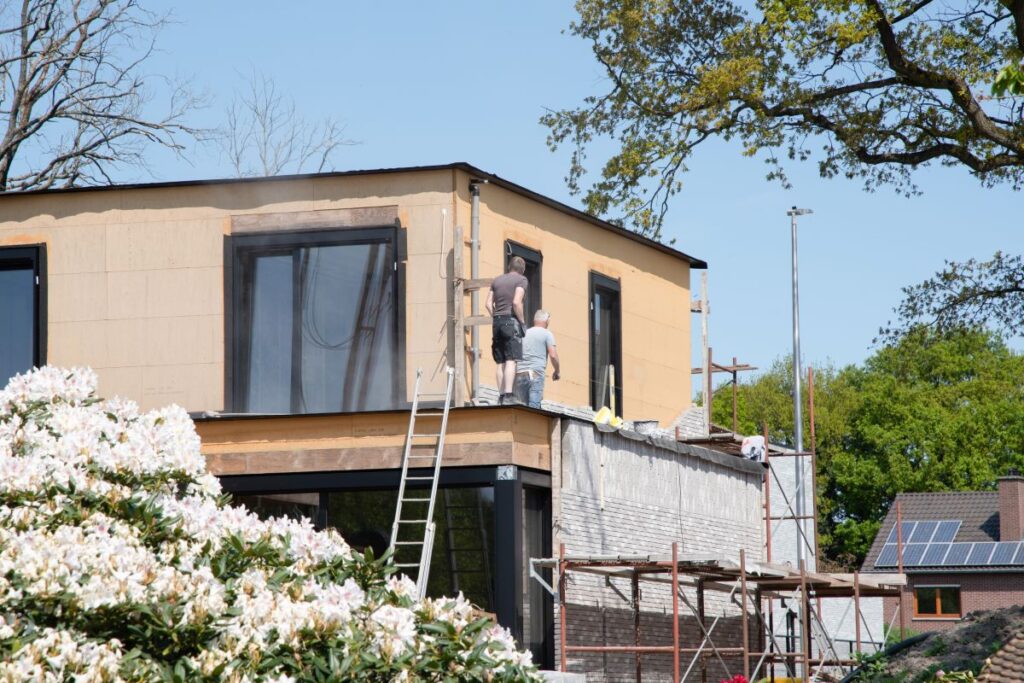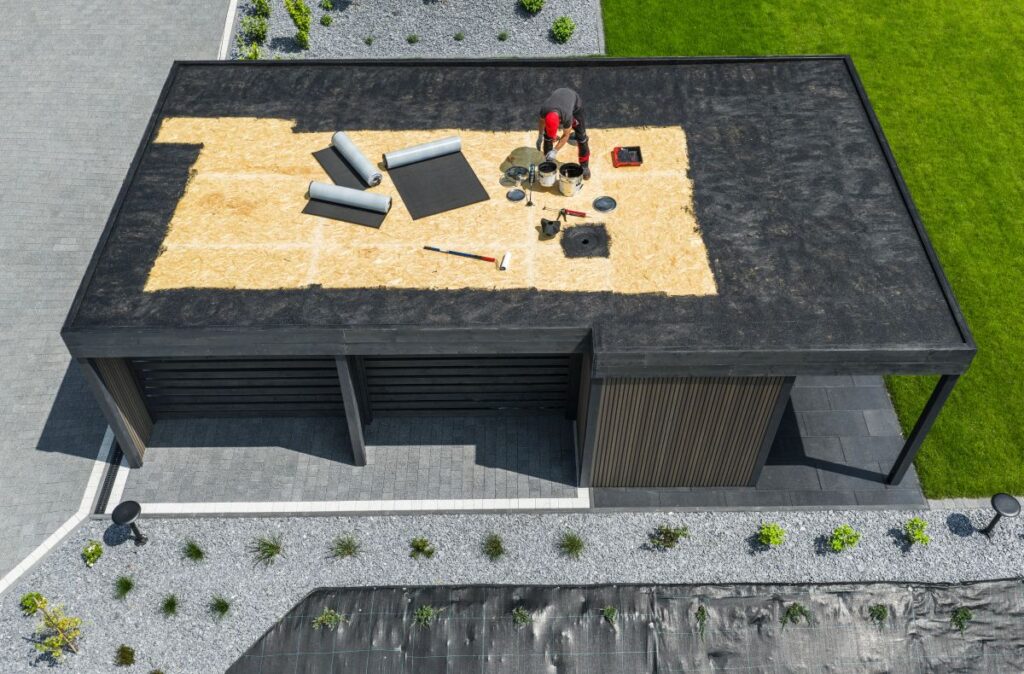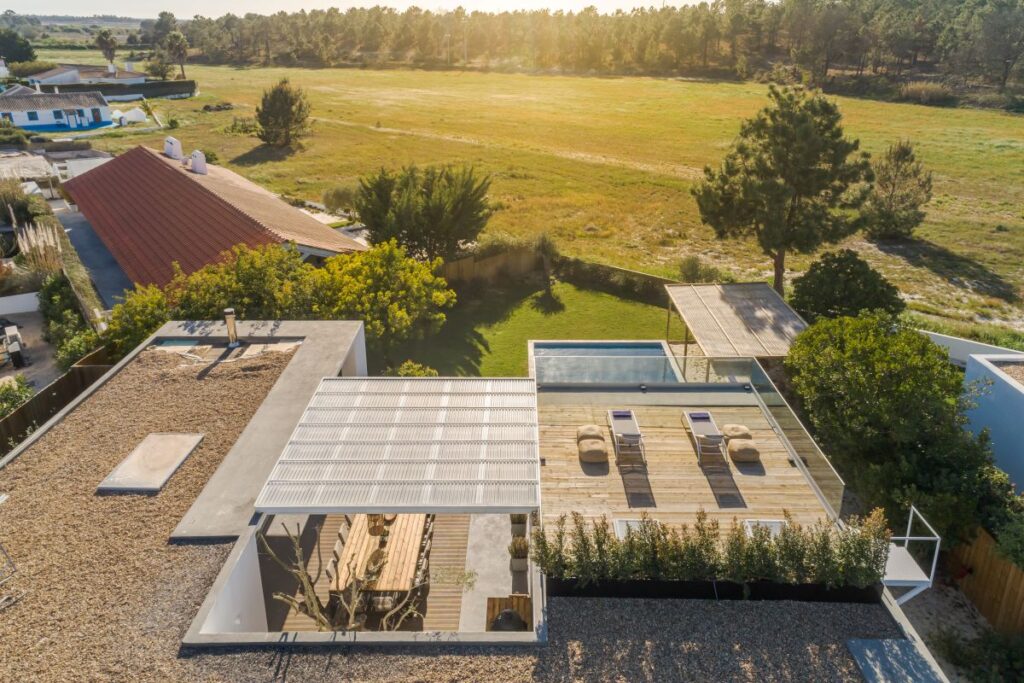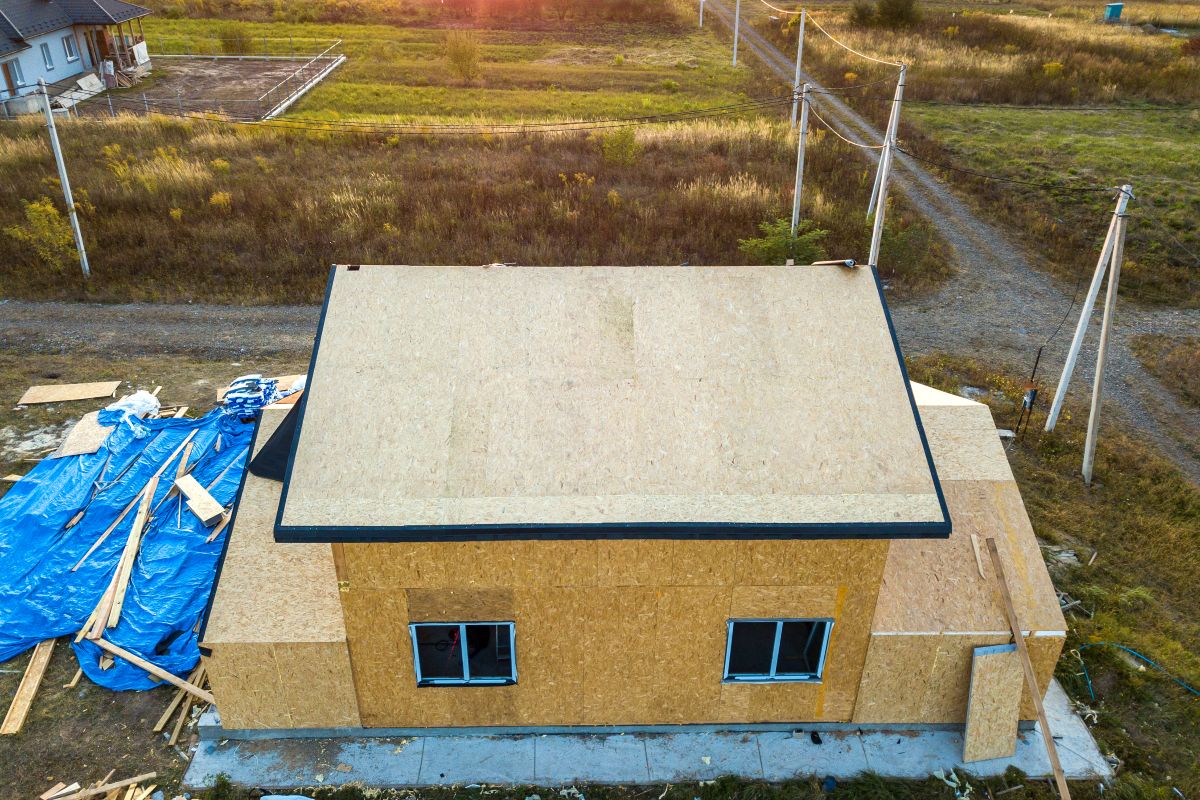Table of Contents
- Introduction: Summer Rain Challenges for Commercial Flat Roofs in Calgary
- Understanding Common Leak Sources in Flat Roofs
- Roofing Systems & Membranes Best Suited to Calgary’s Climate
- Designing for Drainage: Slope, Drains, and Ponding Water
- Seams, Flashing & Penetrations: Weak Points to Reinforce
- Roofing Coatings & Liquid-Applied Membranes
- Maintenance Plans & Inspection Schedules
- After Storms: Damage Assessment & Emergency Repairs
- Choosing Materials & Contractors Wisely (Total Exteriors’ Approach)
- Frequently Asked Questions
- Conclusion & Call to Action
1. Introduction: Summer Rain Challenges for Commercial Flat Roofs in Calgary
Commercial flat roofs in Calgary face a unique combination of weather stresses. The city is known for:
- Intense summer thunderstorms with heavy downpours in short durations
- Occasional hail, wind, and rapid shifts in temperature
- Freeze-thaw cycles that combined with moisture can exacerbate existing vulnerabilities
These conditions mean that even a well-built flat roof must be designed, installed, and maintained with high standards to avoid leaks—especially during Calgary’s summer rains, when roof drainage is put to the test.
At Total Exteriors, as specialists in full exterior restoration following hail, or wind damage, we understand how a flat roof is a critical component of your commercial building’s envelope. A single leak can lead to interior damage, mold, business disruption, and even structural issues.
Let’s explore in depth how to prevent flat roof leaks, what materials and designs perform best in Calgary, and what you as building owners or managers should watch for.
2. Understanding Common Leak Sources in Flat Roofs
Before prevention, it’s essential to know where leaks commonly originate. By identifying weak points, you can target your upgrades and maintenance effectively.
| Leak Source | Why It’s Vulnerable | What to Watch For |
|---|---|---|
| Drainage issues / ponding water | Flat roofs may have inadequate slope or drains; water accumulates, degrades the membrane and seals over time. | Water that pools more than 24-48 hours after rain, visible sagging, discoloration under roofing. |
| Seam failures | In membrane roofs, seams are often weakest — welding, adhesive, or overlapping joints can degrade. | Separation of seams, blistering, bubbles, visible gaps. |
| Flashing & roof penetrations (vents, HVAC curbs, pipes, skylights) | These intersections present opportunities for water ingress if not properly sealed and detailed. | Rusted or deteriorated flashing, loose fasteners, cracked sealants. |
| Membrane damage (cracks, punctures, UV degradation) | Membranes degrade under UV, hail, foot traffic, debris. Over time they can crack or puncture. | Tiny tears, surface cracks, thinning membrane, discolouration or brittleness. |
| Edge and parapet details | Where roof meets walls, parapets, edges—these are stressed zones and often subject to wind uplift or flashing issues. | Cracks along parapet coping, lifting membranes at edges, water intrusion behind wall facades. |
| Insufficient insulation / deck issues | Substrate problems (e.g., damaged deck, poor insulation, moisture under deck) can allow leaks or cause membrane failure. | Soft spots in roof, interior condensation, ceiling stains, blistering. |
| Inadequate maintenance | Without periodic inspection, small issues become big leaks. Debris, clogs, unnoticed damage accumulate. | Blocked drains, debris piles, vegetation, early signs not addressed. |
Understanding these common sources helps you prioritize where to invest—material upgrades, design, or ongoing maintenance.
3. Roofing Systems & Membranes Best Suited to Calgary’s Climate
Choosing the right roofing system is foundational for long-term leak prevention. Below are materials and their pros/cons in the context of Calgary’s summer rains plus overall weather conditions.
| Roofing System / Membrane | Advantages in Calgary | Potential Drawbacks / Considerations |
|---|---|---|
| EPDM (Rubber Membrane) | Very flexible in cold, resists expansion/contraction. Good waterproofing and long lifespan (20-30+ years). Less costly in many cases. | Black EPDM absorbs heat (might raise interior temperature), seams may need more attention. Some EPDM installations are ballasted which adds weight; fully adhered systems cost more. |
| TPO (Thermoplastic Olefin) | Highly reflective (good for summer heat), UV resistant, welded seams (few weak points), relatively lightweight. Good option for commercial roofs. | Welded seams require skilled installation. Some lower-quality TPO can shrink or degrade over time. Reflective surfaces may show dirt easily. |
| PVC Roofing | Similar to TPO in reflectivity and seam performance; often more chemical resistant (beneficial around exhausts or where pollutants are present). | Initial cost higher; sometimes more sensitive to improper installation, particularly around heat or chemical exposures. |
| Modified Bitumen (SBS / APP systems, Torch-on) | Robust material, good in Calgary for resisting thermal movement, hail, foot traffic. Torch-on systems are particularly good at sealing. | If not installed properly (overlaps, flashings), can fail. Torch-on involves fire-risk during installation. In hot weather might get soft; in cold may harden or crack if not polymer modified. |
| Liquid-Applied Membranes / Coatings | Can seal existing weak spots, form seamless waterproof layers, helpful for irregular shapes, penetrations, or patching after damage. Good for maintenance. | Thickness and adhesion critical. Coatings may need reapplication. They may not replace the need for a full membrane in cases of structural damage. |
When selecting, consider your roof’s slope, exposure (sun, hail, wind), traffic, penetrations, and how much maintenance you’re willing to commit to.
4. Designing for Drainage: Slope, Drains, and Ponding Water

Poor drainage is one of the leading causes of leaks, especially in summer when sudden rains can dump lots of water quickly. Here are design and retrofit strategies to manage water properly.
4.1 Proper Slope / Tapered Insulation
- Even “flat” roofs need a slight slope (commonly 1–2%, or about 1/8-inch per foot or more) to direct water to drains.
- Use tapered insulation panels or slope to drains during roof build or replacement. Identify low spots and level them.
4.2 Ample Drains, Scuppers, and Overflow Provisions
- Ensure enough roof drains are installed, positioned logically, and are large enough for peak rainfall.
- Use scuppers (wall or parapet openings) as secondary overflow paths.
- Consider secondary / emergency drainage to prevent overflow if primary drains clog.
4.3 Avoiding Ponding Water
- For areas where water tends to settle, raise insulation or add tapered boards to re-direct water flow.
- Ensure membranes are continuous and slope transitions are smooth.
- Remove or adjust equipment, curbs, or other rooftop structures that obstruct drainage.
4.4 Roof Edge / Parapet Design
- Parapet walls and edges must be sealed properly and often have coping or metal flashings designed to shed water.
- Drip edges, gutters, gravel stops help prevent water from backing onto roof edges.
4.5 Maintenance of Drainage Systems
- Keep drains, scuppers, gutters, and downspouts clean, free of debris. Especially before and after major rains or storms.
- Inspect strainers or grates, ensure they are not blocked.
5. Seams, Flashing & Penetrations: Weak Points to Reinforce
These are usual locations where leaks begin. Proper attention to details here can make the difference between a tight roof and one with persistent drip issues.
5.1 Membrane Seams
- Welded seams (hot air or heat weld for TPO / PVC), adhesive or roll seams in bitumen systems must be installed by qualified installers.
- Seam overlap width must follow manufacturer’s spec.
- Inspect seams periodically; look for separation, bubbles, or signs of moisture infiltration below.
5.2 Flashing Details
- Flashings around parapets, walls, roof-to-wall transitions, and roof penetrations (vents, pipe curbs, skylights) need to be well sealed.
- Use compatible flashing materials. Incompatible metals or membranes can lead to galvanic corrosion or sealant failure.
5.3 Penetrations (HVAC, vents, drains, skylights)
- Penetration points are joining geometry of different materials and shapes—more risk.
- Use curb flashings, proper collars, pitch pans, boot flashings, ensuring proper sealant detailing.
- Make sure that these penetrations are not causing ponding (i.e. depressions around units).
5.4 Thermal Movement & Expansion Joints
- Calgary has significant temperature swings (day/night, seasonal). Materials expand/contract: design for movement.
- Use expansion joints or allow for movement in the membrane to prevent stress, tears, seam failures.
6. Roofing Coatings & Liquid-Applied Membranes

Coatings can be an effective preventive or remedial measure. They help seal weak spots, protect membranes from UV, and extend lifespan.
6.1 Types of Coatings
- Elastomeric coatings: flexible, stretchable, good for sealing cracks.
- Polyurethane or silicone coatings: often used around penetrations or in areas with high ponding.
- Reflective coatings: reduce thermal stress in summer by reducing solar heat absorption.
6.2 Liquid-Applied Membranes
- These are seamless, adhesive or chemically cured systems that adhere over existing surfaces or create new waterproof layers. Useful for patches, balconies, curbs.
- Must follow strict surface prep (cleaning, priming, making sure substrate is sound).
6.3 When Coatings Are Suitable vs When Replacement Is Needed
| Condition | Coating / Liquid Membrane Likely Enough | Replacement / Full Membrane Needed |
|---|---|---|
| Minor cracks, small leaks, aging UV surface but structure sound | Yes | |
| Significant membrane failures, persistent ponding, delamination, substrate rot | Likely full replacement so that coating adheres properly and covers all weak spots |
7. Maintenance Plans & Inspection Schedules
Prevention isn’t just good design & materials—it’s ongoing care. Regular inspections and maintenance are essential, especially for commercial flat roofs in Calgary’s climate.
7.1 Frequency & Timing
- Inspect twice a year—ideally spring (after snow melt) and fall (before freeze).
- After major storms, hail, or high winds — check immediately.
7.2 What to Inspect
- Drainage paths: Are drains, scuppers, downspouts clear? Any signs of blockage?
- Membrane condition: cracks, blisters, blisters, crazing, punctures.
- Seams & flashings: secure, sealed, no gaps or loose sections.
- Penetrations: tight flashings, no leaks around HVAC units or other roof equipment.
- Roof edges, parapets: check coping, metal flashings, edges for rust or sealant failure.
- Interior signs: water stains, mold, musty smells.
7.3 Cleaning & Debris Removal
- Remove leaves, branches, trash that block drains or collect on the roof.
- Trim overhanging trees that might drop debris or damage membrane.
7.4 Record Keeping
- Document inspections (photos, notes).
- Keep track of when and what repairs were done.
- Use maintenance contracts so that scheduled care happens reliably.
7.5 Budgeting for Minor Repairs
- Small repairs early often avoid big costs later (e.g. patching a small torn section vs replacing large areas).
- Invest in quality sealants & patch materials suited for your membrane type.
8. After Storms: Damage Assessment & Emergency Repairs
Summer storms, hail, sudden heavy downpours—these can expose vulnerabilities very quickly. Having a response plan is key.
8.1 Inspection Following Storms
- After hail or wind events: check for membrane damage, punctures, loose flashings.
- Use infrared or moisture detection scans if leaks are not visibly obvious.
- Check for any new standing water (ponds), especially around drains or parapets.
8.2 Temporary / Emergency Fixes
- Temporary sealing materials (roof tapes, patch kits) can plug leaks short term.
- Divert water flow temporarily if drains are blocked.
- Board up or cover exposed areas to prevent water ingress until permanent repair is possible.
8.3 Permanent Repairs
- Replace damaged membrane sections, re-seal or reinstall degraded flashings.
- Repair or replace drains, scuppers, overflow systems if they failed.
- If damage is extensive (multiple leak sources, substrate rot, structural issues), full replacement may be needed.
9. Choosing Materials & Contractors Wisely (Total Exteriors’ Approach)
At Total Exteriors, our approach to preventing leaks in commercial flat roofs combines strong materials, thoughtful design, and rigorous execution.
9.1 Material Selection
- We recommend membrane systems like EPDM, TPO, or modified bitumen responsive to Calgary’s weather, with strong UV stability, good seam quality, and compatible flashing systems.
- For high-risk areas or places with frequent hail, we may opt for thicker membranes or reinforced base sheets.
- Use of protective coatings or liquid membranes where appropriate, especially in complex penetration zones or retrofit work.
9.2 Design & Engineering
- Ensuring proper slope or tapered insulation from the start (or retrofit) so water moves efficiently.
- Adequate drainage layout including primary drains, scuppers, overflow paths.
- Thoughtful location of equipment to avoid impeding drainage.
9.3 Quality Installation
- Skilled teams: Seams welded correctly; flashings sealed; penetrations properly detailed.
- Premium adhesives, sealants compatible with membranes.
- Inspection during construction to catch potential leak paths (e.g. edge transitions, seams).
9.4 Maintenance & Follow-Up
- We usually recommend twice-annual inspections plus checks after storms.
- Maintenance contracts are offered so buildings don’t slip into neglect.
- Prompt repair of small issues before they escalate.
9.5 Responsiveness for Storm Damage / Exterior Restoration
- Total Exteriors is experienced in storm, hail, wind damage. When leaks or damage happen, we do damage assessments, work with insurance, and execute rapid repairs / restorations.
- We document before/after, use infrared / moisture scanning when needed to find hidden damages.
10. Frequently Asked Questions

Q1: How long should a well-installed flat roof last in Calgary?
A: Depending on the system used, quality of materials, installation, and maintenance, many commercial flat roofs (EPDM, TPO, modified bitumen) should last 20-30 years or more. Harsh weather, hail damage, or persistent ponding can reduce lifespan.
Q2: Can ponding water cause leaks, even if the membrane is intact?
A: Yes. Even if the membrane seems fine, standing water over time degrades seams, softens flashings, causes substrate saturation, promotes membrane fatigue. It also traps debris and supports algae or vegetation which can damage the membrane.
Q3: Does a reflective or white roof membrane help with leak prevention?
A: Indirectly, yes. Reflective membranes reduce heat buildup, which reduces thermal stress and expansion/contraction cycles that strain seams and flashings. It doesn’t prevent leaks by itself but helps reduce stress and wear.
Q4: What maintenance frequency is necessary to keep a flat roof leak-free?
A: At minimum twice per year (spring & fall), plus after big storms. More frequent inspections if roof has many penetrations, heavy foot traffic, or is older. Promptly clean drains and repair small damage when noticed.
Q5: How much does it cost to do preventive maintenance vs. emergency fixes?
A: Preventive maintenance (cleaning drains, small patching, sealant work) tends to be a relatively small cost annually, but can avoid large interior damage costs, loss of business, and major replacement costs. Emergency fixes are usually more expensive (both direct repair + damage mitigation), so prevention is cost-efficient in the long run.
11. Conclusion & Call to Action
Preventing leaks on commercial flat roofs in Calgary isn’t a one-and-done task—it requires careful selection of materials, thoughtful design for drainage, attention to vulnerable areas (seams, flashings, penetrations), and a consistent maintenance strategy. Throw into the mix Calgary’s intense summer rains, hail events, and rapid temperature shifts, and you see how easily weak spots on a roof can become serious problems.
At Total Exteriors, we bring the experience of full exterior restoration to commercial roofing. We don’t just replace membranes — we design systems to last, inspect thoroughly, and repair proactively. If your commercial flat roof is showing signs of strain, or you want a preventive review before the next big storm, reach out.
12. Call to Action
Don’t wait until the next summer thunderstorm reveals a leak. Contact Total Exteriors Ltd. for a comprehensive flat roof inspection. We’ll assess your roofing membrane, drainage, flashings, and recommend repair or reinforcement solutions tailored to Calgary’s climate. Protect your building, your operations, and your bottom line — schedule your assessment today.

